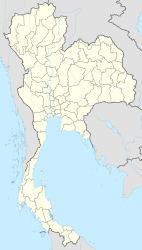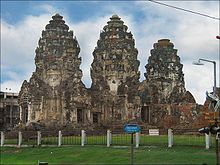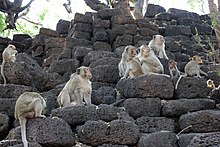Lop Buri
|
ลพบุรี Lop Buri |
||
|---|---|---|
|
|
||
| Coordinates | 14 ° 48 ' N , 100 ° 39' E | |
| Basic data | ||
| Country | Thailand | |
| Lop Buri | ||
| ISO 3166-2 | TH-16 | |
Lop Buri ( Thai ลพบุรี , also reproduced as Lopburi ; old name: Lavo ) is the capital of the district ( Amphoe ) Mueang Lop Buri and the province of Lop Buri in the central region of Thailand .
etymology
The name Lop Buri (from Sanskrit Lava-puri ) means "City of Lava". In the Indian mythology of the Ramayana epic, lava is one of the twin sons of Rama and Sita .
geography
Lop Buri is located on the river of the same name and comprises a very large urban area in the middle of the fertile plain of Maenam Lop Buri. To the north of the city, the Khao Wong Phra Chan stands out impressively with three pointed points.
The distance to the capital Bangkok is about 150 kilometers.
Economy and Transport
The city thrives on high-yield agriculture: rice, cotton and corn are the main products.
Lop Buri has a station of the Thai state railway on the north runway , the Bangkok with Chiang Mai connects.
history
Lop Buri (historically Lavo) is one of the oldest cities in Thailand. According to the "Chronicle of the North", it was founded in 468 by Indian colonists under Kaḷavarṇadiś from Taxila (now in Pakistan) under the name Lavo . The oldest evidence from Lop Buri itself dates back to the 7th century and testifies to a Mon town as part of the Dvaravati culture. It was one of the most important centers in this network of predominantly Buddhist city-states in what is now central Thailand and the most important one east of Mae Nam Chao Phraya . Its culture was strongly influenced by the Indian one, which is why it is counted among the " Indianized states " of Southeast Asia. Silver coins from the 7th or 8th century found in the U Thong excavation site bear the inscription Lava on one side and Pura on the other side in a Pallava- like Indian script , so the city was probably called Lava-pura at that time . According to tradition, Chamadevi , the legendary (but probably historical) founder of the Mon city-state of Haripunjaya (today Lamphun in northern Thailand), which is around 500 kilometers further north, was a princess of Lop Buri.
From the 10th century , Lop Buri came under the influence of the Khmer Empire of Angkor and became one of the most important provincial centers in the western part of its dominion. His “governor” had the rank of viceroy. But there were also aspirations for independence, at least Lop Buri (Chinese Lo-hu ) sent his own embassies to China in 1115 and 1155 under the Song dynasty . The most important monuments from the Khmer period are the Wat Phra Sri Rattana Mahathat and Prang Sam Yot , the symbol of Lop Buri. Both date from around 1200, the reign of Jayavarman VII of Angkor. The style of the Khmer buildings and works of art in today's area of (central) Thailand is also called Lop Buri style .
With the decline of the Khmer influence, Lop Buri gained independence in the middle of the 13th century . It is not clear what role the Thai played in this. In any case, Lop Buri was at the end of the 13th century under the influence of the Thai king Ramkhamhaeng of Sukhothai . After his death, Sukhothai lost control of central Thailand and Lop Buri became an independent city-state again. U Thong (as King Ramathibodi I ), the founder of the Ayutthaya Kingdom , which dominated what is now Thailand from the 14th to 18th centuries, may have come from the princely family of Lop Buri. After Ayutthaya was founded, Lop Buri functioned as a kind of “second capital”: the designated heir to the throne with the rank of viceroy usually resided here. With the growth of Ayutthaya's sphere of influence, however, Lop Buri's importance waned. After the kingdom of Sukhothai fell to Ayutthaya in personal union in 1438, Phitsanulok, hundreds of kilometers further north, became the "second capital".
The city only regained importance when King Narai had Lop Buri expanded into a strategic fortress in 1664 due to the constant threat from the Burmese and made it his second capital. At first it was only a starting point for hunting wild elephants and tigers, but in the end Narai resided here for most of the year and not in the actual capital Ayutthaya, much like his contemporary Louis XIV of France who went from a hunting lodge to Versailles main residence. The French traveler Nicolas Gervaise wrote at the time that Lop Buri ( Louveau in French ) "is to the Kingdom of Siam what Versailles is to France." Narai probably not only enjoyed the opportunities for diversion, but also the somewhat more informal court protocol and the distance from the intrigues at the court of Ayutthaya. French Jesuits , who had great influence at the court of Narai, which was very open to Western influences, designed the Narai Ratchaniwet palace , the first secular stone building in Siam. The first official embassy of the French king to the court of Siam also resided in Lopburi in a specially built stone villa in the style of the European Renaissance. Constantine Phaulkon , a Greek adventurer who had risen to become Chancellor and "Foreign Minister" Narais, later moved in .
The royal elephant minister Phetracha , who overthrew Narai in a "revolution" in 1688 and made himself king, had no interest in Lop Buri and it was becoming less important again. However, there are still many remains of the once magnificent royal seat. In contrast to Ayutthaya, Lop Buri was not razed to the ground when the kingdom was conquered by the forces of the King of Ava in 1767. King Rama IV (Mongkut, r. 1851–68), who was the first king to seriously deal with the history of his own country, had the Narai Ratchaniwet palace partially reconstructed and stayed there occasionally. During the imperialist age, consideration was given to moving the capital of Siam from Bangkok back to Lop Buri because it is further inland and therefore not so susceptible to external attacks. The nationalist Prime Minister Plaek Phibunsongkhram had one of the most important bases of the Thai army built in Lop Buri in the 1930s and 40s. It is still an important garrison town today.
Attractions
- Phra Narai Ratcha Niwet ( พระ นารายณ์ ราช นิ เวสน์ ) - Palace of King Narai in Lop Buri, built between 1665 and 1677. The design comes from French Jesuits who had been settled in the capital Ayutthaya since 1662 . The Chantarapisarn Pavilion was opened in 1924 by Prince Damrong Rajanubhab and Prince Narisara Nuwattiwong as the "Lopburi Museum", which today houses a large collection of historical and antique art objects in several buildings.
- Statue of King Narai - in honor of the promoter of urban development in the 17th century.
- Wat Phra Sri Rattana Mahathat ( วัด พระ ศรี รัตน มหาธาตุ ) - large Buddhist temple complex ( Wat ) with a high prang; the original building existed before the arrival of the Khmer. ( See also: Wat Mahathat ).
- Phra Prang Sam Yot ( "Three Saints Prang" - พระ ปรางค์ สาม ยอด ) - three laterite - Prang (from the Khmer period 11th century ), under Narai was a viharn grown of a Buddha statue from the Ayutthayazeit houses.
- The city is plagued by crab-eating macaques who hang around Prang Sam Yot in particular. They are only tolerated as they attract numerous tourists. Feeding the monkeys is not permitted in the city.
- San Phra Kan ( ศาล เจ้าพ่อ พระ กาฬ ) - a Brahmin shrine, across from Prang Sam Yot, built in 1951, contains a highly venerated four-armed statue with a Buddha head. Behind the shrine you can see the remains of a Khmer prang, which is now used as a "monkey sanctuary" where the monkeys can be fed.
- Wat Thong Thong - from the Ayutthaya period, but in a western style
- Ban Wichayen - ruins of the residence of Constantine Phaulkon , the Greek-born minister under King Narai.
- Prang Khaek - small Khmer style Hindu shrine.
Personalities
- Thanapong Boonthab (born 1995), football player
- Makawan Kerdanan (born 1997), football player
- Adisak Klinkosoom (* 1992), football player
Web links
- City map of Lop Buri (names in English and Thai) [last accessed on November 5, 2013]
Individual evidence
- ^ Santosh N. Desai: Hinduism in Thai Life. Bombay 1981, p. 64.
- ^ Adhir Chakravarti: India and South-East Asia. Socio-econo-cultural contacts. New Delhi 1999.
- ^ Volker Grabowsky : Brief history of Thailand. CH Beck, Munich 2010, ISBN 978-3-406-60129-3 , p. 22.
- ↑ George Cœdès : The Indianized States of South-East Asia. 1968.
- ↑ JJ Boeles: A Note on the Ancient City called Lavapura. In: Journal of the Siam Society , Volume 55, 1967, pp. 113-115.
- ^ Robert S. Wicks: Money, Markets, and Trade in Early Southeast Asia. The Development of Indigenous Monetary Systems to AD 1400. Cornell Southeast Asia Program, Ithaca (NY) 1992, p. 165.
- ↑ Elizabeth E. Broadrup: Ayutthaya. In: International Dictionary of Historic Places. Volume 5: Asia and Oceania. Routledge, London / New York 1996, p. 52.
- ↑ a b Dhiravat na Pombejra: Lopburi (Lawo). In: Southeast Asia. A Historical Encyclopedia, From Angkor Wat to East Timor. Volume 1, ABC-CLIO, Santa Barbara (CA) 2004, p. 793.
- ^ Nicolas Gervaise: Histoire naturelle et politique du royaume de Siam. Paris 1688. Original quote: "Louveau, que les Siamois appellent communément Noccheboury, est une Ville qui est, pour ainsi dire, dans le Royaume de Siam ce que Versailles est en France."
- ↑ Dhiravat na Pombejra, in: Southeast Asia. 2004, p. 794.




